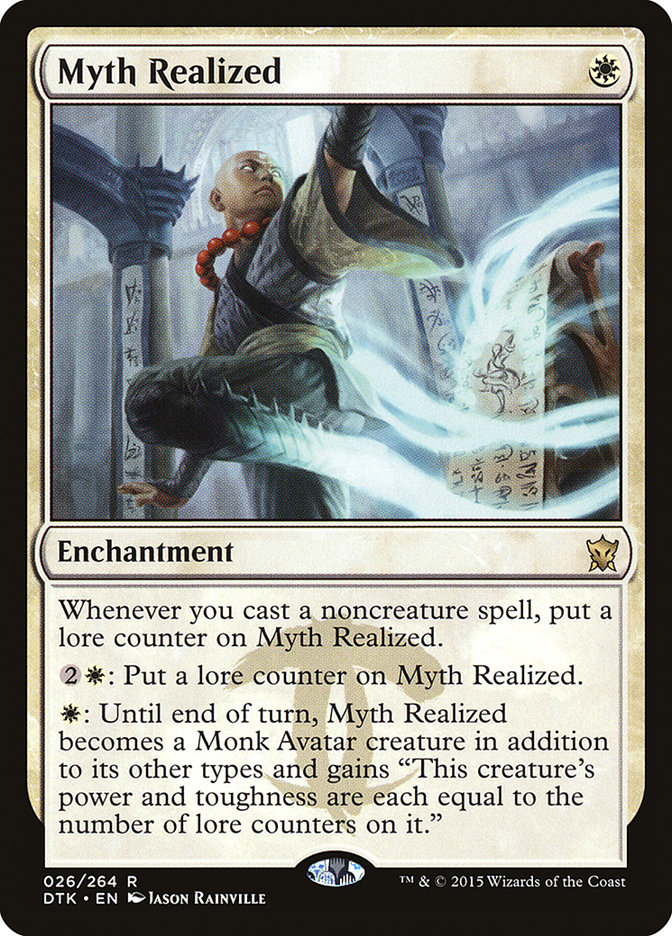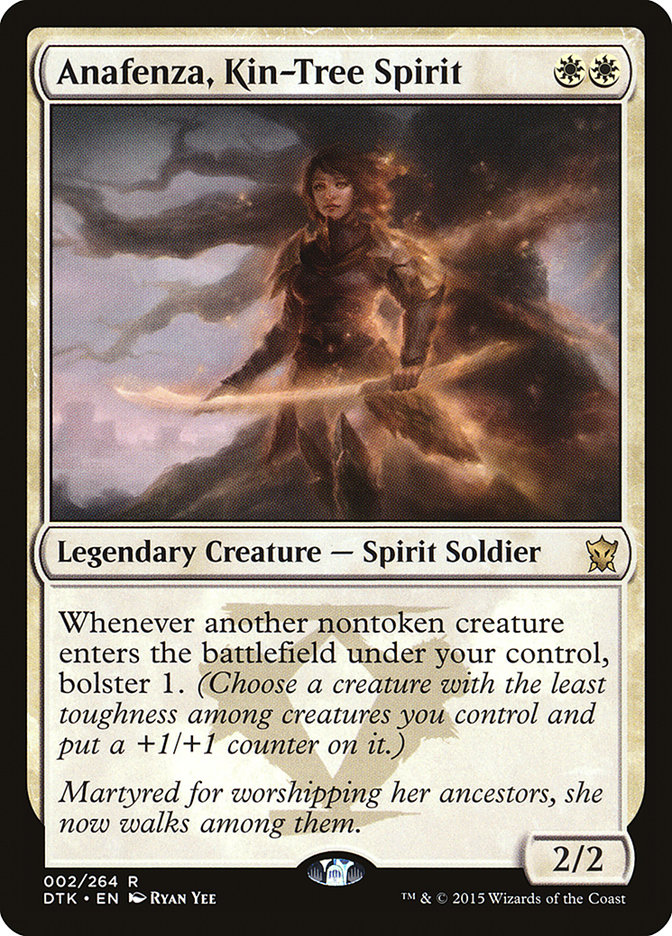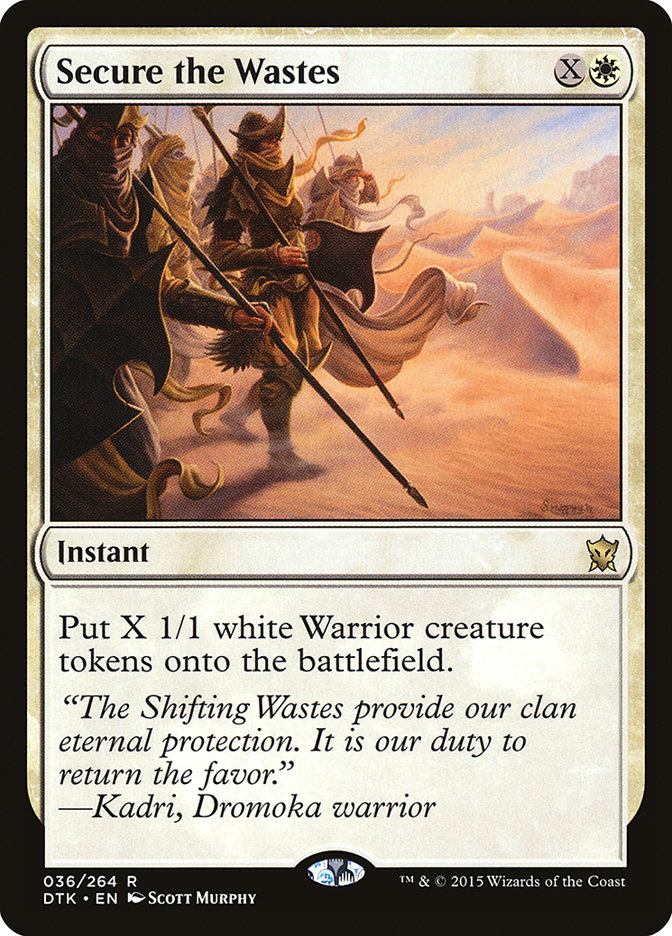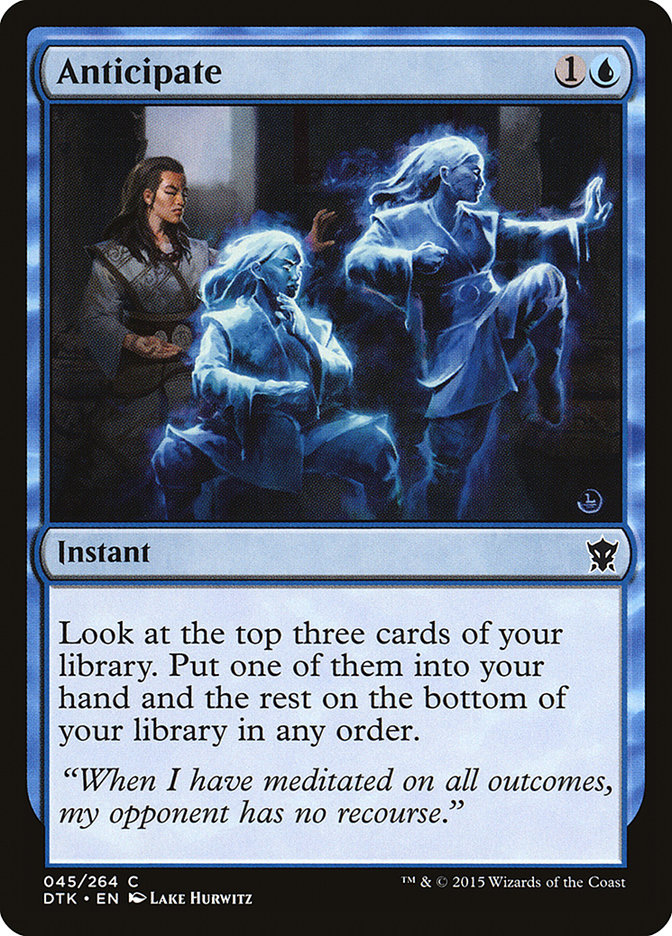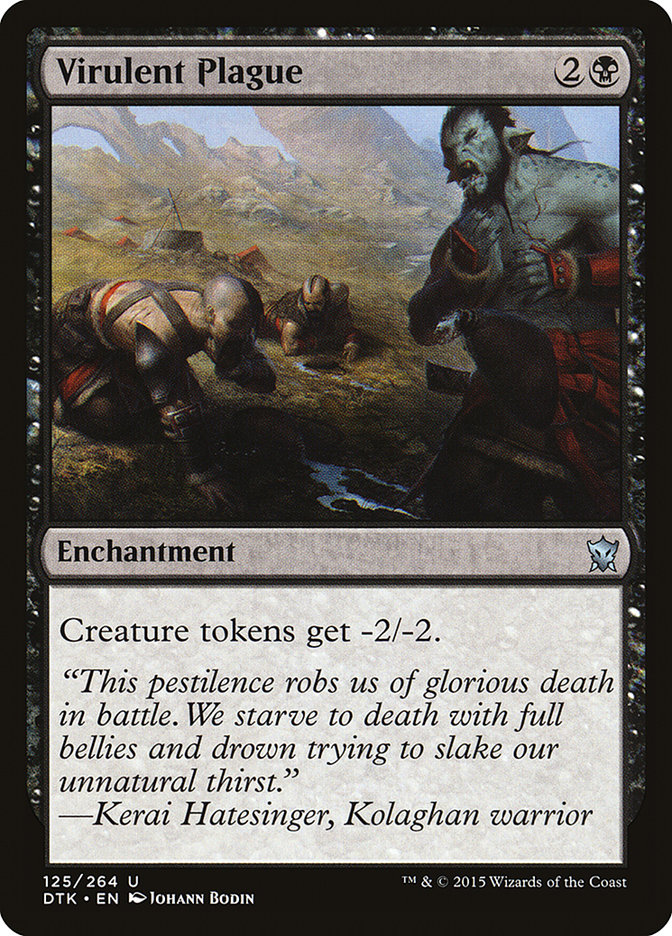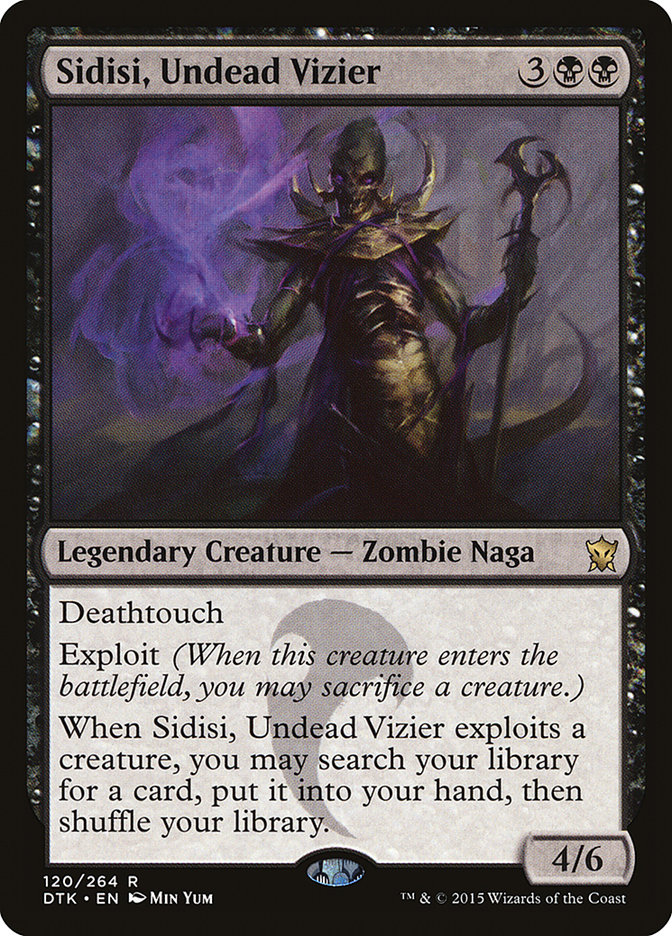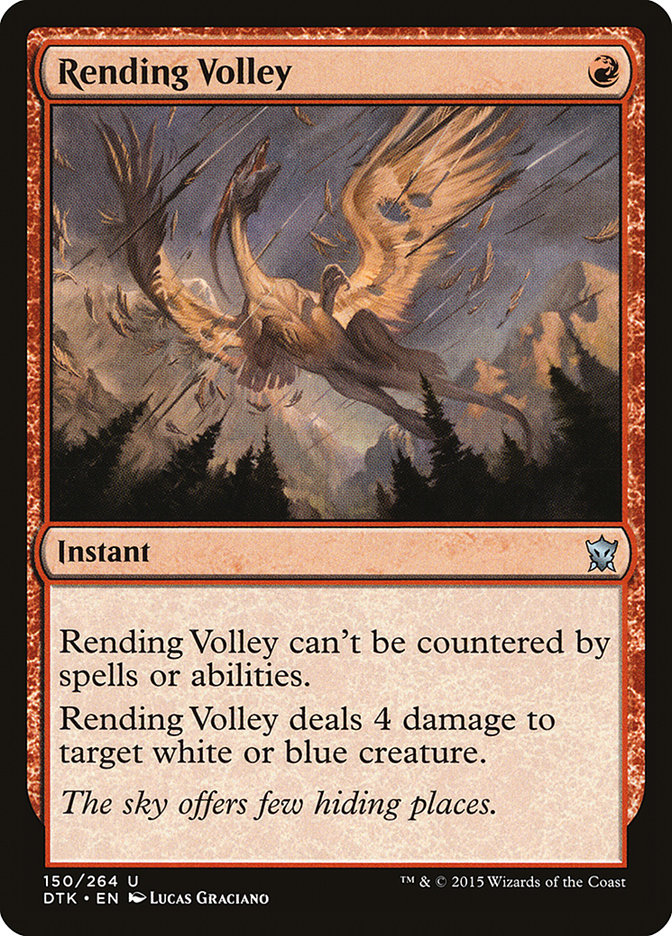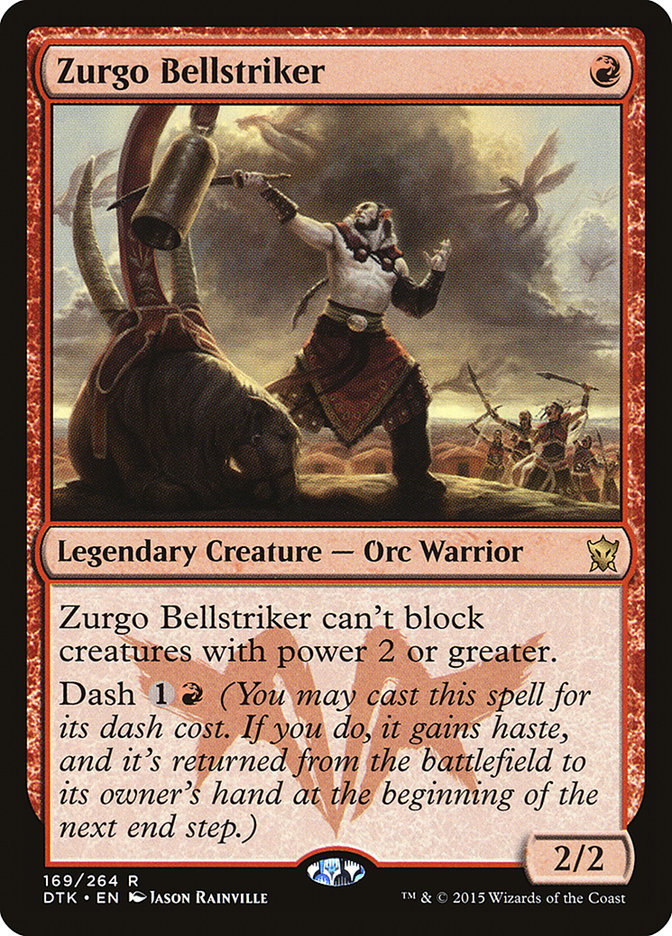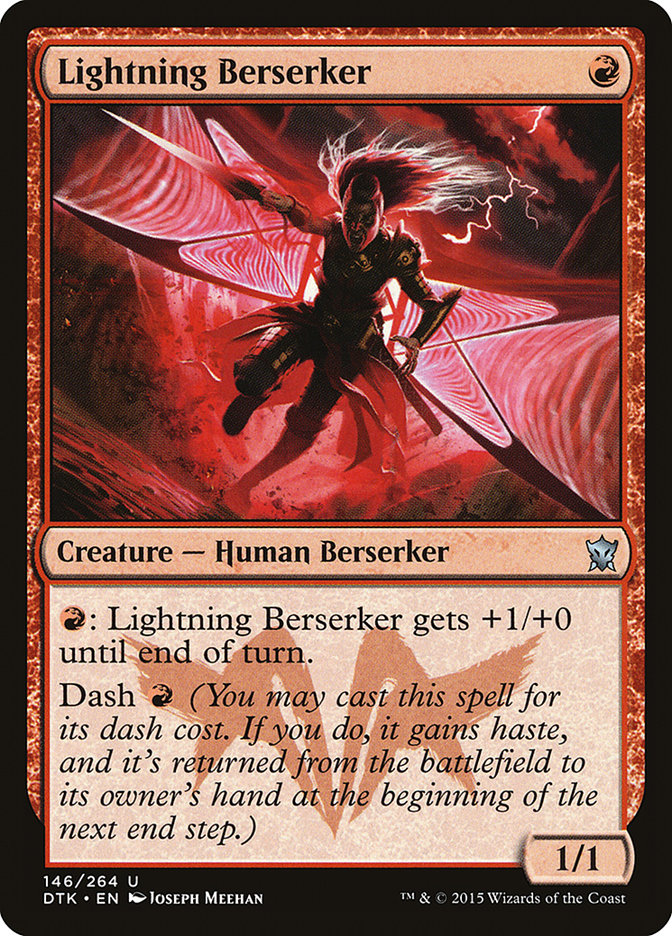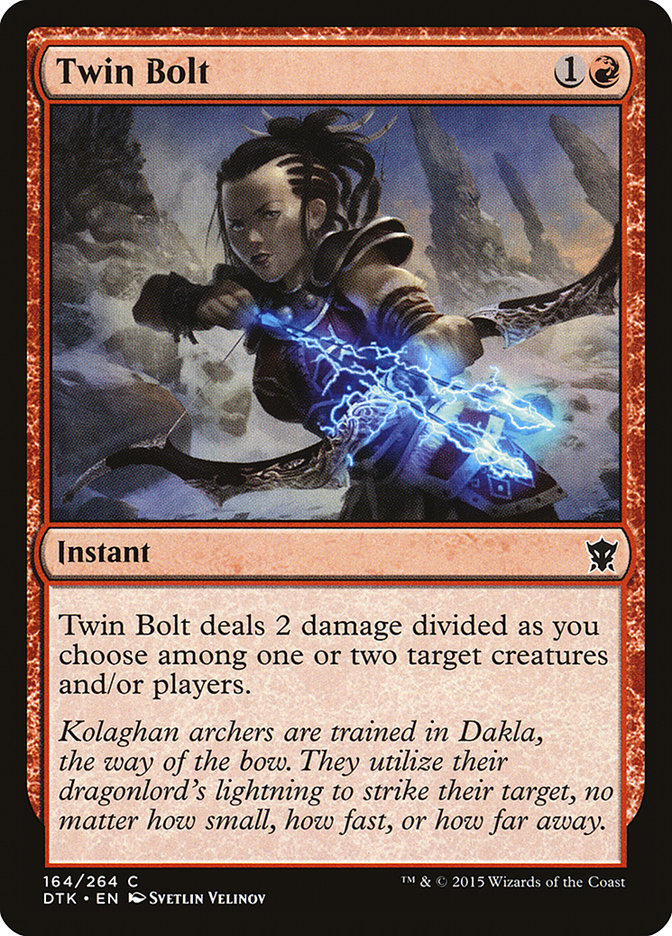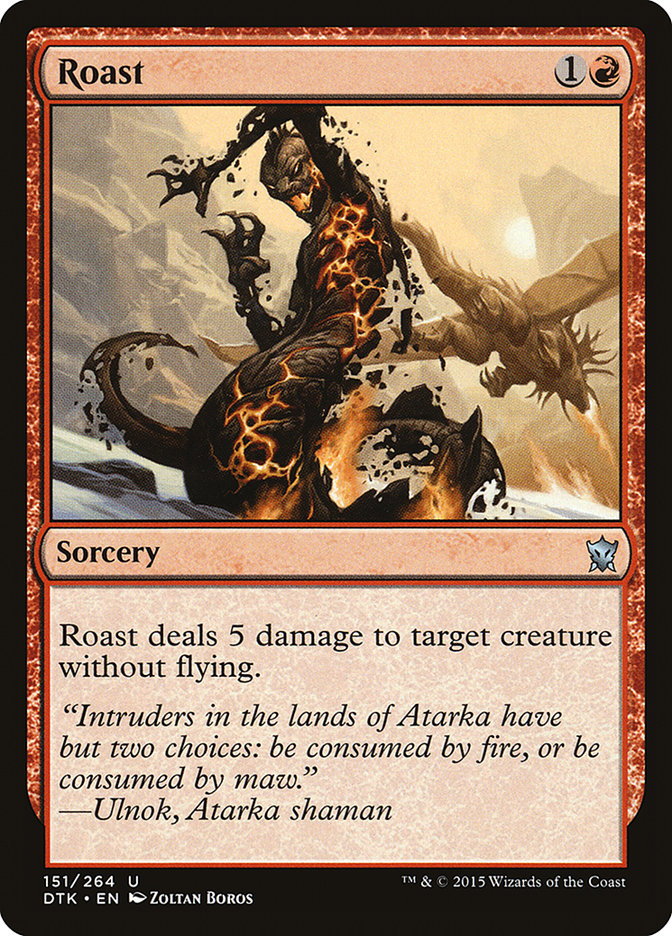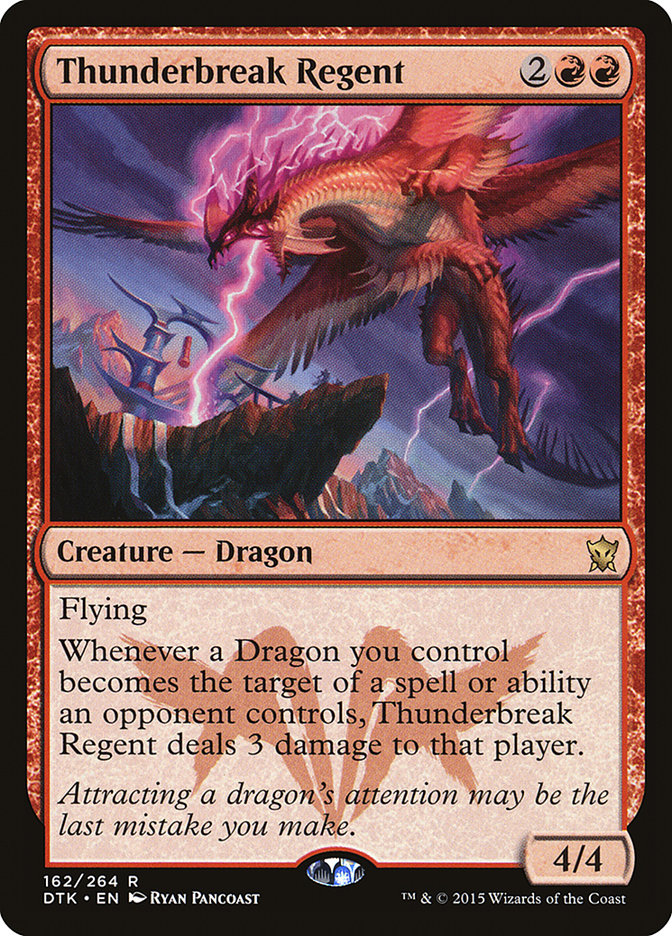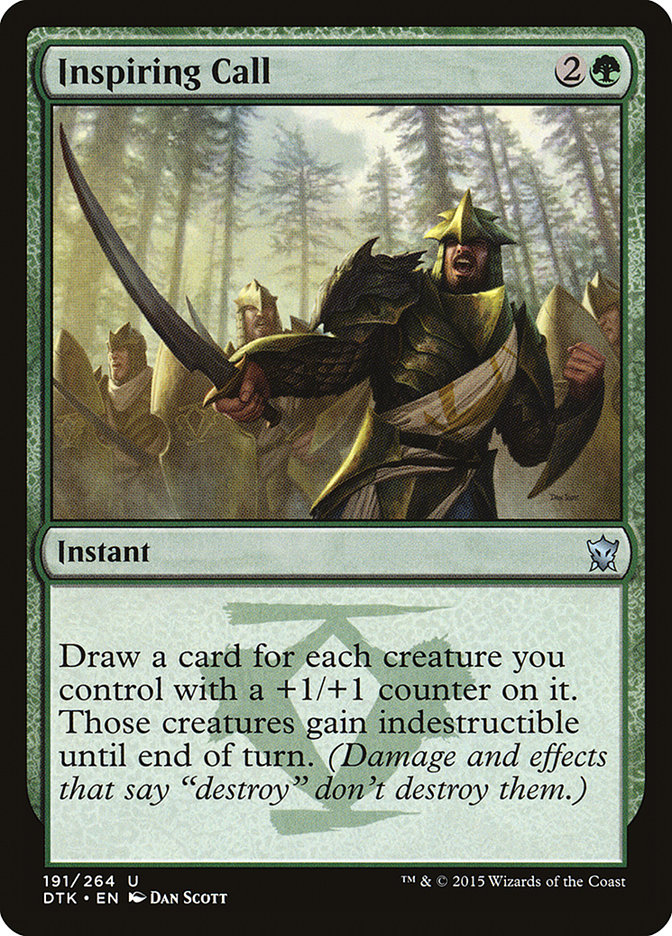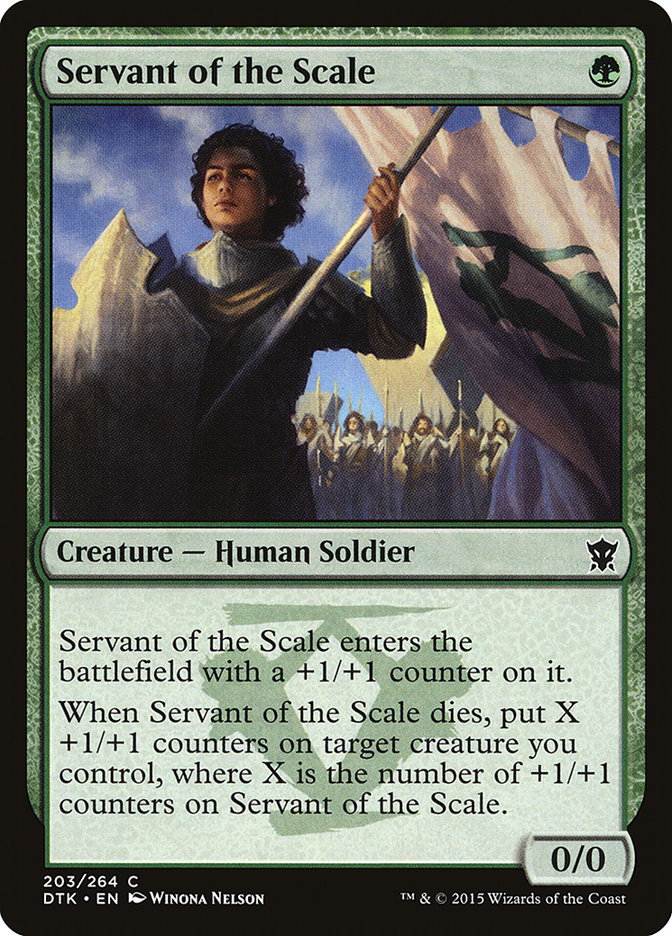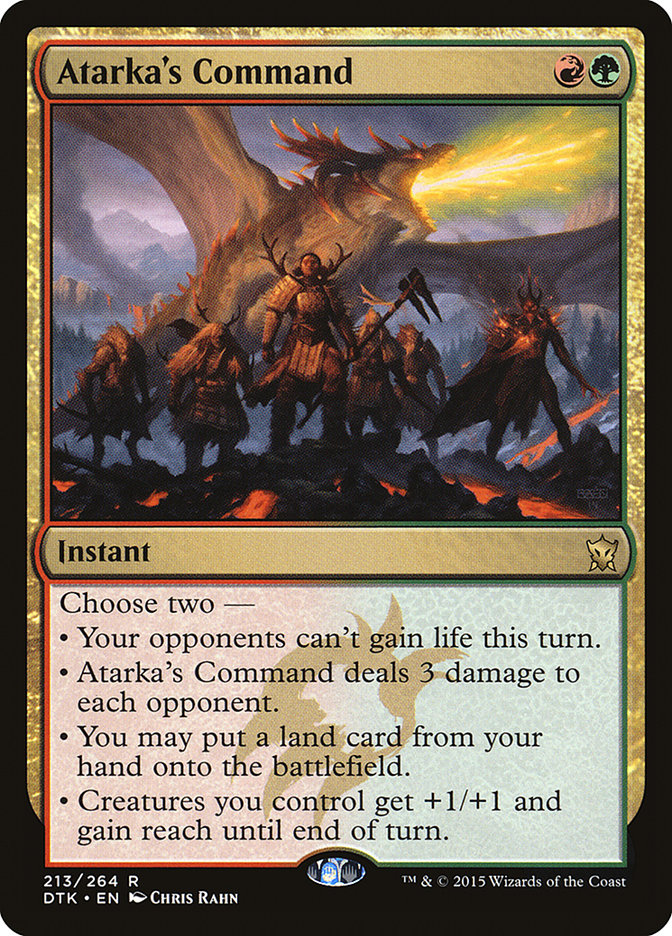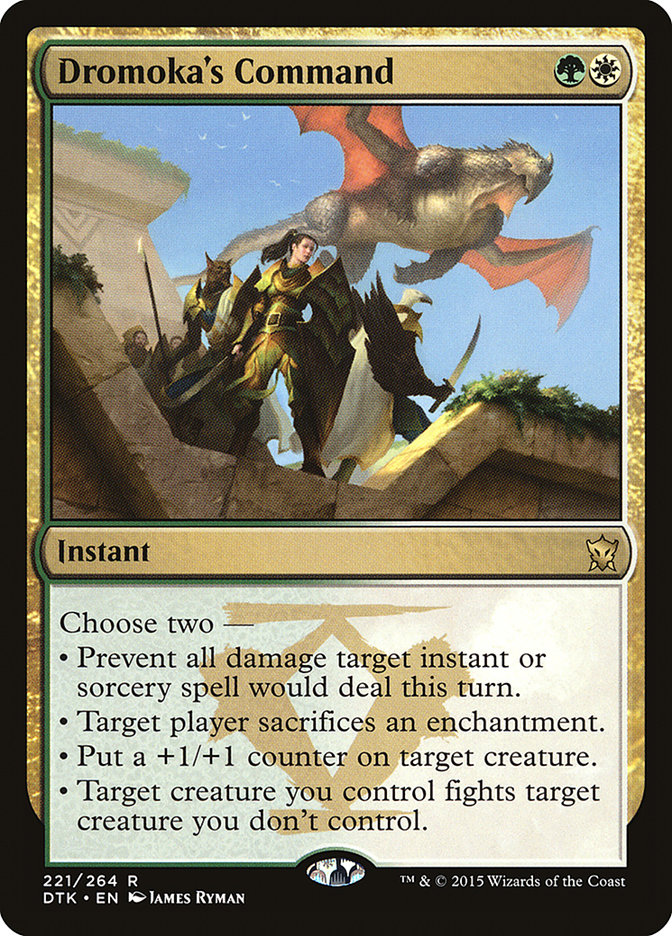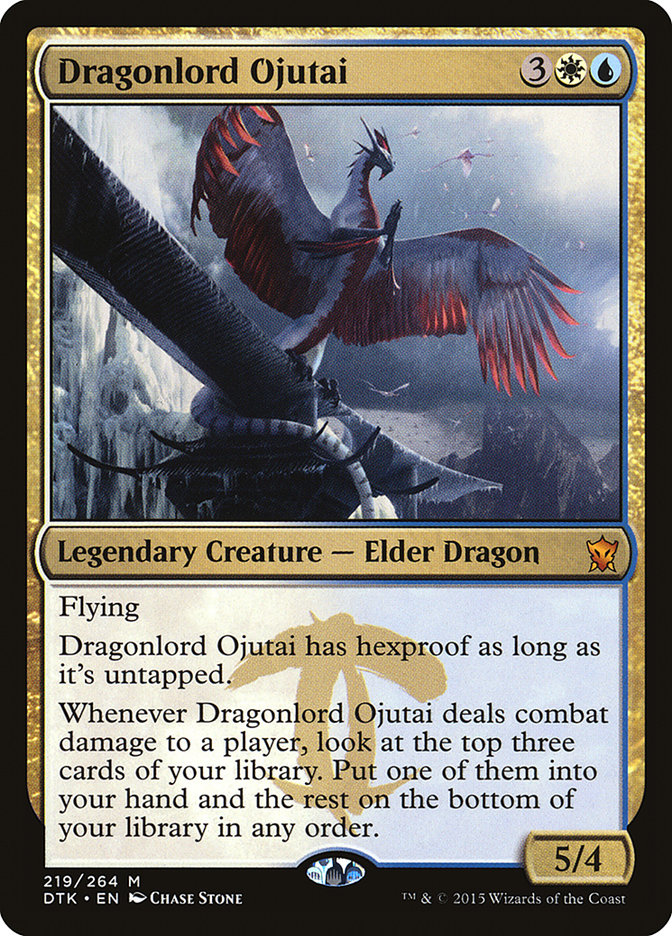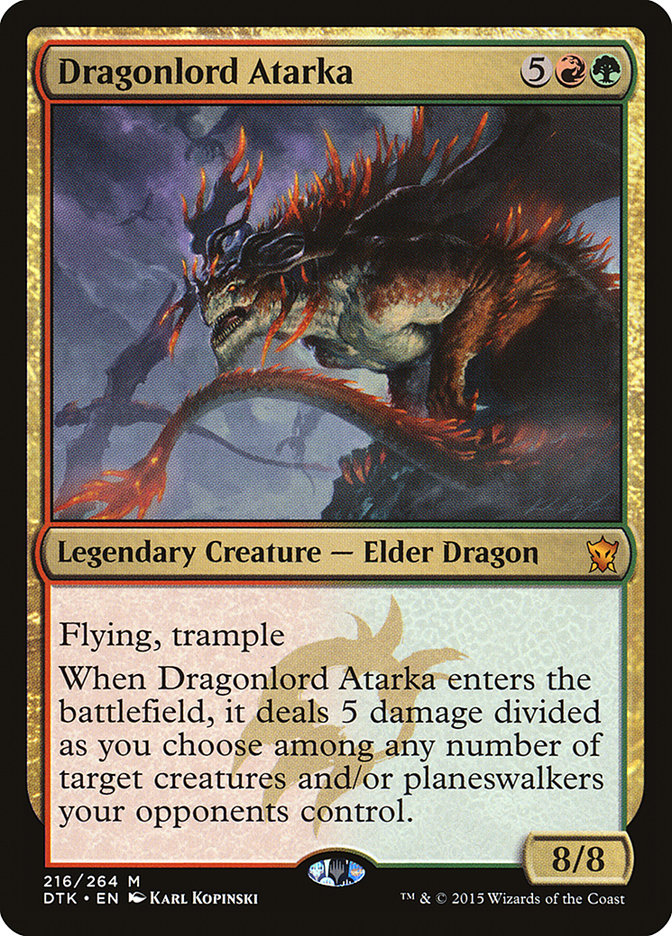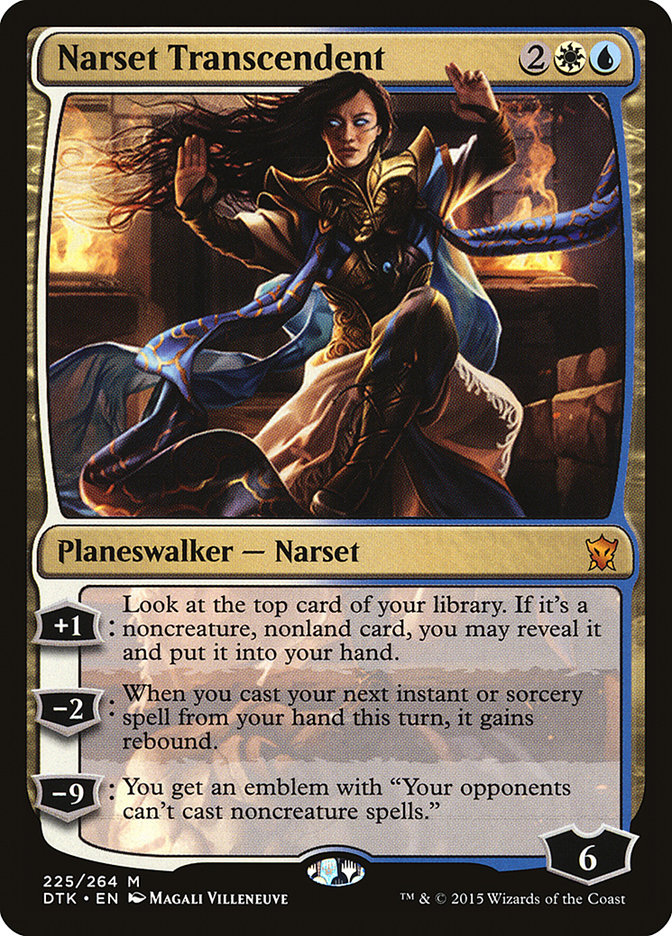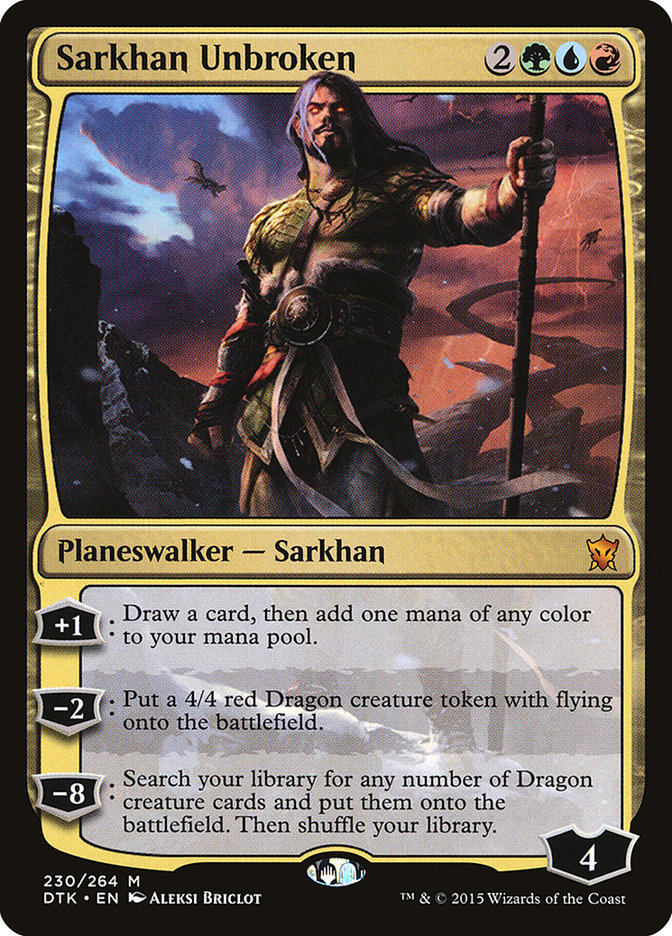When I went to the Dragons of Tarkir Prerelease, I was surprised to learn that players there thought Dragons of Tarkir was a weak set for Constructed. As
someone who was looking at the set for Standard and as someone who easily gets excited to try new things, this set looked like a gold mine to me. They
explained that they were Modern players, and they just didn’t feel like the set did much for that format. Well, first of all, that’s kind of the point of
Modern–no single new set will change things that much, but given that, I think Dragons of Tarkir is a great set for Modern. Obviously, if your metric is
Khans of Tarkir, Dragons doesn’t bring anything like Treasure Cruise or allied fetchlands, but I think it still brings a lot to the table, and today, I’d
like to go over the cards I’m interested in for Modern.
White
While the best one-mana cantrips (Ponder and Preordain) are banned in Modern, it’s still a format where you can play a lot of spells very quickly if you’re
in the market to do so. Myth Realized gets very big very quickly in a W/U/x Delver-style shell. It dodges sorcery speed removal, and you can wait until
it’s big enough to get out of range of red removal or Dismember if you need to. People will still have answers to it like Abrupt Decay, but even with Path
to Exile, if you want, you can make sure it’s only a creature when you have mana available to counter their removal spell. This isn’t the fastest threat,
but it’s not slow either, and the investment is low.
The best way to take advantage of everything this card brings to the table is to play a deck with cheap cantrips that don’t want to tap out, where this
will allow you to deploy a high impact, relatively resilient threat in a deck that needs to use very few cards to win the game for only a single mana,
which means you never have to give your opponent a window.
Is this better than Delver of Secrets? No, it’s a different card. Delver is better when you’re trying to establish a quick clock and start attacking. This
is better when you’re trying to play a longer game or a game with fewer threats and you need each to do a bit more lifting than Delver of Secrets. The fact
that the comparison isn’t clear or that it’s close says a lot about the power level of this card.
This is a card I can get into. It’s getting attention as a second Melira, Sylvok Outcast, which is definitely warranted, but remember that this card is a
lot more than that. First of all, it does do that, which is great, but it’s also just a much better card (ignoring the more difficult casting cost) in
those decks. Melira is generally a vanilla 2/2 that sometimes lets you win through a combo. Anafenza, Kin-Tree Spirit is Anafenza Kin-Tree Spirit that
sometimes lets you win through a combo. What I mean is that the text is just very relevant for normal games of Magic. These decks play a lot of creatures,
and getting counters whenever they enter the battlefield really contributes to your other plan, just attacking with your creatures.
More copies of Melira, Sylvok Outcast’s isn’t that exciting because people usually played 1-3 copies of Melira anyway, but being able to play eight does
offer the option of trying to make a deck that’s extremely dedicated to the combo. The combo requires three parts: either of those, a persist creature, and
something that lets you sacrifice something. This allows you to sacrifice the persist creature infinitely. There are enough playable persist creatures that
you can play 8-10 fairly easily between Safehold Elite, Kitchen Finks, and Murderous Redcap. With Safehold Elite, it entering the battlefield doesn’t do
anything, so just sacrificing it to something like a Cartel Aristocrat won’t win you the game, but there are a lot of other things you can sacrifice things
to that will win the game, like Blasting Station. Or you could use Viscera Seer to draw the final piece to win the game the next turn, or you could use a
creature like Bloodthrone Vampire that will win the game if it can hit your opponent, or you could play a support card like Blood Artist to win the game on
the spot.
Personally, I’m most excited to try this in a shell like the deck I build for Pro Tour Fate Reforged that my friend David Heineman played and discussed here. I think Safehold Elite is a pretty good
fit for the deck anyway, as it plays really well with Abzan Ascendancy, and Anafenza-Kin Tree Spirit seems great here both as a combo piece and a regular
creature.
There’s a very real possibility that this card isn’t good enough, but I think it’s worth considering as a one- or two-of in a deck that can use the tokens
well, like W/B Tokens or in a control deck that’s looking for an instant-speed threat.
Blue
We already have Telling Time, and Telling Time is pretty close to flatly not good enough. The effects are very similar, and neither reads as “strictly
better” than the other, but I’d argue that Anticipate is a much better card than Telling Time. On the surface, it’s easy to think that it’s not clear
whether you’d generally rather keep one or two of three cards you look at. After all, the middle card should be about average quality for your deck, but
that ignores the important context in which people actually play these cards. You only play a card like this when you want to be able to find something
specific, and when you’re looking for one single card, you definitely don’t want to have to keep two. If you’re trying to find a Scapeshift at the end of
your opponent’s turn, this gets you a full card deeper at no extra cost of any kind, and that’s a huge upgrade. People who have played with Telling Time
and dismissed it as not quite good enough shouldn’t ignore Anticipate as “just another one of those.”
I think Telling Time is bad, Impulse would be a format staple, and Anticipate is right on the line where some decks will likely want it, but don’t go
overboard, a lot of decks don’t want to spend two mana without impacting the board.
Black
The competition between this and Illness in the Ranks is interesting. In general, you’d like to have the one-mana spell rather than the three-mana spell,
but when the card is trying to singlehandedly KO the opponent, the difference might not matter much. Obviously, if every token you’re trying to kill is
1/1, this is much worse, and if they’re all 2/2 or bigger, this is much better. Most tokens in Modern are 1/1, but a deck like W/B Tokens plays cards like
Intangible Virtue that make them all bigger, negating the effect of your Illness in the Ranks. Illness in the Ranks is still great there, as it’s mostly
neutralizing one of their best cards, but it’s nowhere near as good as the Plague, which will either lock them out or answer two of their best cards.
I don’t have high hopes for Sidisi, but it’s at least worth considering. It’s big enough to win a fight against a Siege Rhino and too big for red removal
or Abrupt Decay, and the ability is very good. I’d want to have Satyr Wayfinder and Lingering Souls in my deck (which happen to work well together) to fuel
my Sidisi, but once I’m doing that, I think this is definitely a curve topper worth considering, and it will play especially well in post-sideboard games
when it gives you better access to your sideboard trumps.
Red
This card was clearly designed for Modern as a better tool against Splinter Twin. Costing one mana instead of two compared to Combust makes it much easier
to use, so this is a huge upgrade to what was already one of the best tools against them. This card kills everything Combust kills except Siege Rhino
outside of fringe exceptions like Baneslayer Angel, and it should be widely played.
It’s not as good as Goblin Guide at doing what Goblin Guide does, but it’s probably the next best one-drop after Goblin Guide and Monastery Swiftspear. It
hits for a good amount each turn when you cast it on turn 1, and when you draw it late, it gets damage in right away. I’m no red expert, but it looks like
a serious consideration for Burn decks depending on how many creatures they want to play.
I wouldn’t play a lot of these, but I think it might actually be a good one-of in Burn. When you’re done doing your other stuff, or whenever your opponent
happens to tap out, this can suddenly take a huge chunk out of their life total.
Going a little deep? Maybe, but what if you use Impact Tremors to build a R/W “Melira combo” deck with Anafenza, Kin-Tree Spirit, Safehold Elite, and
Greater Gargadon? Or what about the Norin the Wary deck with Genesis Chamber? This does a ton of damage in conjunction with those cards. It could also lead
to R/W Tokens becoming a deck. It’s not a sure thing, because this either goes into a fringe deck or creates a new deck, but this is definitely a
high-impact card.
Fire//Ice vs Forked Bolt is an interesting question in Legacy, but is just Fire vs Forked Bolt a question in Modern? Likely not, but instant speed is a big
upgrade, so it’s worth keeping in mind, as nothing in the format does exactly this job in a strictly better way.
Is this good enough for Modern? We could pay one less mana for Flame Slash and hit fliers, so we need to be really concerned with five toughness creatures
to want to go this way, but, as it happens, five is a pretty important number of toughness at the moment thanks to Siege Rhino and Tasigur, the Golden
Fang, and five makes it that much more likely to kill Tarmogoyf. You should never see this in a maindeck in Modern, but I can definitely imagine it coming
up as a sideboard card.
This one’s much less likely, but I think it’s at least worth considering. Its numbers put it just outside the range of Lightning Bolt and Abrupt Decay, and
even if the opponent can kill it, the three to six damage they’ll take doing so isn’t trivial, and at that point, it rules the skies, matching up favorably
against the biggest flying opposition, Restoration Angel.
Green
Likely? Absolutely not, but it does do something that can be very powerful that few other cards do, but with Doran, you might be able to have enough access
to count on having the effect in play, and let’s not forget about the Mardu Ascendancy interaction.
I think we’re probably just short of enough creatures that naturally give themselves counters that are good enough to make this work, but I don’t think
we’re very short. Another set or two with a theme like unleash or evolve and this might have a home. If the effect works on all your creatures and your
deck has a lot of creatures and you don’t have to do a lot of work to get to that point, this is an incredibly powerful effect. The question is just how
bad our creatures have to be to make this work. Still, if we just start with Champion of the Parish, Experiment One, and Anafenza, Kin-Tree Spirit, we’re
not that far off.
Another approach might be to play this in Affinity with Arcbound Worker and Steel Overseer, but it’s probably not the best use of a precious non-artifact
slot.
Maybe if instead of playing creatures that have counters, we just play cards like Ajani Goldmane and Abzan Ascendancy? Probably requires too much set up at
that point, but this effect is just so powerful.
I wouldn’t mention this if it weren’t for Inspiring Call, but is there any chance this could be good enough if that’s what we’re doing? It’s very weak, but
if our deck cares about counters and has other ways to put counters on it, and especially if we can sacrifice this at instant speed so that it counts as a
combat trick, there could be a chance.
More help for the above, and it also happens to just have good numbers in an aggressive deck with Experiment One, and maybe Rakdos Cackler. Maybe white was
the wrong way to go–maybe Experiment One, Rakdos Cackler, Servant of the Scale, Avatar of the Resolute, and something like Gore-House Chainwalker would be
the way to get Inspiring Call going? That doesn’t sound quite right, but we’re so close, I feel like maybe a few gatherer searches rather than trying to do
this from memory might actually get there.
This could be great in the deck mentioned above or any of the Anafenza, Kin-Tree Warden decks. This card is great and definitely seems worth exploring in
Modern to me. It’s very easy to find 24-28 good creatures that cost under three mana in Modern, and then this is big game. One particularly exciting option
to me is combining this with Eternal Witness to run it back. This will quickly bury anyone who’s trying to win by using spot removal on your creatures.
Gold
This card is outstanding. This is like Skullcrack, except it will do way more damage on average. This is a huge upgrade for Burn, but it’s even better for
Zoo. In Zoo, as a combat trick, it will often make you win multiple fights if people don’t learn to play against it, or save your creatures from Anger of
the Gods or any other red sweeper, or deal around six damage. When it’s winning combats or countering sweepers, it’s also dealing three damage. If you put
any effort into building a swarm strategy, this gets even better. This is still my pick for best card in the set for Modern.
This is likely better in Standard, but countering burn spells is great in Modern, and it does its usual job as a flexible G/W removal spell. The big
differences are that I think there are fewer enchantments played in Modern, and two mana is actually a lot for a removal spell in Modern. Still, this is a
card I could see considering a few of.
This is another one that’s not at all likely, but again, it’s a consideration because it fills this role in a unique way. There isn’t a top end threat
that’s clearly better at dodging removal and closing a game than this.
This is even less likely, but this is a huge legendary creature that does something fairly unique and doesn’t have an anti-reanimation clause, so I could
see it making its way into a Goryo’s Vengeance deck or sideboard or some other Reanimator deck.
I don’t have a good enough sense of exactly how strong this card is yet, but I do know that Burn is a common way to try to deal with planeswalkers in
Modern, and this laughs at that plan. I was impressed watching the card in Shaheen’s deck on SCGLive in Standard, which doesn’t necessarily mean it’s good
enough, but if Jace, Architect of Thought is starting to make its way into Modern, this definitely seems worth trying.
The hardest thing about using Sarkhan is getting three colors of mana, but that’s a lot easier in Modern, and once you do it, this card is incredible. It
immediately makes a dragon and then both the dragon and the planeswalker absolutely demand relatively fast answers. This is as real as a two-for-one gets,
and it absolutely dominates if left unanswered.
Those are the cards that I find interesting for Modern. This list is intended to be exhaustive, but I might have missed something. I don’t think this set
will fundamentally alter the texture of Modern, but I definitely think it offers some great tools and could lead to some new solid decks. For Modern
enthusiasts, I think there’s plenty here.

